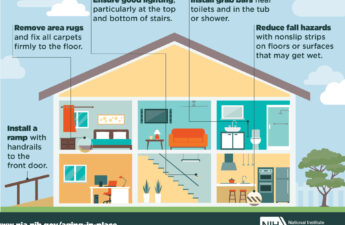
From the University of Michigan, VA and the University of Pennsylvania
ANN ARBOR, MI – They may start as well-intentioned efforts to calm anxiety, improve sleep or ease depression. But prescriptions for sedatives known as benzodiazepines may lead to long-term use among one in four older adults who receive them, according to new research.
That’s despite warnings against long-term use of these drugs, especially among older people, because they can increase the risk of car crashes, falls and broken hips, as well as causing other side effects.
The new study, published in JAMA Internal Medicine by a team from the University of Michigan, VA and University of Pennsylvania, looked at benzodiazepine use by low-income older adults in a Pennsylvania program that helps with drug costs.
The researchers say their findings point to a strong need for better education of healthcare providers, and the public, about the risks associated with these drugs.
Of the 576 adults who received their first benzodiazepine prescription in 2008 to 2016, 152 still had a current or recent prescription a year later.
The study only included people whose benzodiazepines were prescribed by non-psychiatrists, as the majority of older adults who use benzodiazepines have their prescriptions written by primary care physicians or other non-psychiatrists.
White patients were four times more likely to have gone on to long-term use. Those whose initial prescriptions were written for the largest amounts were also more likely to become long-term benzodiazepine users.
For just every 10 additional days of medication prescribed, a patient’s risk of long-term use nearly doubled over the next year.
That rate of long-term use is concerning enough in itself, says Lauren Gerlach, D.O., M.Sc., the lead author of the study and a geriatric psychiatrist at U-M.
“This shows that we need to help providers start with the end in mind when prescribing a benzodiazepine, by beginning with a short-duration prescription and engage patients in discussions of when to reevaluate their symptoms and begin tapering the patient off,” she says. “We also need to educate providers about effective non-pharmaceutical treatment alternatives, such as cognitive behavioral therapy, for these patients.”
Gerlach points to two other concerning findings from the review of records and detailed interviews with program participants. Long-term benzodiazepine users were no more likely to have a diagnosis of anxiety, which is sometimes an indication for long-term use.
Also, long-term users were more likely to say they had sleep problems, despite the fact that benzodiazepines are not recommended for long-term use as sleep aids and may even worsen sleep the longer they are used.
Gerlach and her colleagues at the U-M Medical School, VA Ann Arbor Healthcare System, Corporal Michael Crescenz VA Medical Center and University of Pennsylvania used data from the Supporting Seniors Receiving Treatment and Intervention, or SUSTAIN, program.
The program provides a supplement to a Pennsylvania medication coverage program for low-income older adults. The program provides behavioral health and case management services by telephone across the state. All of the patients in the study live at home or in other community settings, so the study does not include patients in nursing homes and other skilled nursing facilities.
This included detailed interviews to screen for mental health issues including anxiety, depression, sleep issues and pain, as well as analysis of prescription records and other clinical data.
The researchers calculated a medication possession ratio, based on how many days’ supply of benzodiazepines the person had been prescribed, and how many days remained in the time the prescription was valid.
They set a threshold MPR of 30 percent over the course of a year as the definition of long-term use.
On average, the patients were 78 years old when they received their first benzodiazepine prescription – an advanced age for use of the drugs, which national guidelines say should rarely if ever be given to adults over about age 65. Very few had had any sort of psychiatric, psychological or psychosocial care in the past two years.
While treatment guidelines recommend only short-term prescribing, if any, these long-term patients were prescribed nearly 8 months’ worth of medication after their initial prescription.
“This study provides strong evidence that the expectations set out by a provider when they first write a new prescription carry forward over time,” says David Oslin, M.D., of Penn Medicine and the Philadelphia VA, and senior author of the paper.
“When a physician writes for 30 days of a benzodiazepine, the message to the patient is to take the medication daily and for a long time. This expectancy translates into chronic use which in the long run translates into greater risks like falls, cognitive impairment and worse sleep,” he said.
“Since mental health providers see only a very small minority of older adults who have mental health issues, we need to support primary care providers better as they manage these patients’ care,” says Gerlach. “We must help them think critically about how certain prescriptions they write could increase the chance of long-term use.”
Donovan Maust, M.D., M.S., another U-M geriatric psychiatrist who has studied overuse of benzodiazepine drugs and risks associated with them, is a co-author. He and Gerlach are both members of the U-M Institute for Healthcare Policy and Innovation, and the Program for Positive Aging in the U-M Department of Psychiatry.
Says Oslin, “Benzodiazepines are one of several classes of medications that have a high addictive potential and substantial risks for falls, cognitive dulling, and sleep impairment. From a public health perspective, starting 80-year-old patients on benzodiazepines is a high-risk prospect. In addition to the risks to the individual, there is also risk for greater drug diversion and exposure of these medications to grandkids if not properly stored and disposed.”
The research was sponsored by the Pharmaceutical Assistance Contract for the Elderly of the Commonwealth of Pennsylvania.
Reference: JAMA Internal Medicine, Sept. 10 2018


